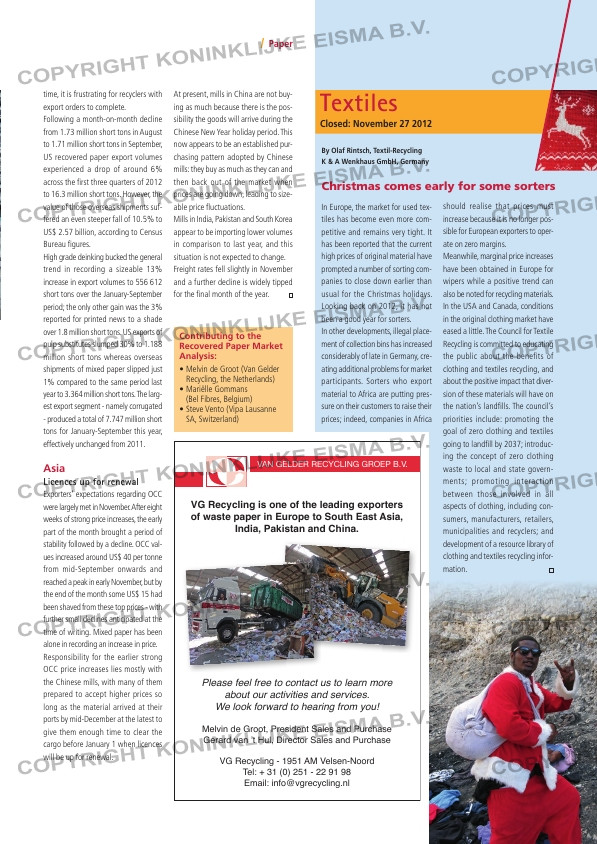Page 47 from: December 2012

47December 2012
Paper
Please feel free to contact us to learn more
about our activities and services.
We look forward to hearing from you!
Melvin de Groot, President Sales and Purchase
Gerard van ’t Hul, Director Sales and Purchase
VG Recycling – 1951 AM Velsen-Noord
Tel: + 31 (0) 251 – 22 91 98
Email: [email protected]
VG Recycling is one of the leading exporters
of waste paper in Europe to South East Asia,
India, Pakistan and China.
VAN GELDER RECYCLING GROEP B.V.
Textiles
Contributing to the
Recovered Paper Market
Analysis:
• Melvin de Groot (Van Gelder
Recycling, the Netherlands)
• Mariëlle Gommans
(Bel Fibres, Belgium)
• Steve Vento (Vipa Lausanne
SA, Switzerland)
Closed: November 27 2012
time, it is frustrating for recyclers with
export orders to complete.
Following a month-on-month decline
from 1.73 million short tons in August
to 1.71 million short tons in September,
US recovered paper export volumes
experienced a drop of around 6%
across the fi rst three quarters of 2012
to 16.3 million short tons. However, the
value of those overseas shipments suf-
fered an even steeper fall of 10.5% to
US$ 2.57 billion, according to Census
Bureau fi gures.
High grade deinking bucked the general
trend in recording a sizeable 13%
increase in export volumes to 556 612
short tons over the January-September
period; the only other gain was the 3%
reported for printed news to a shade
over 1.8 million short tons. US exports of
pulp substitutes slumped 30% to 1.188
million short tons whereas overseas
shipments of mixed paper slipped just
1% compared to the same period last
year to 3.364 million short tons. The larg-
est export segment – namely corrugated
– produced a total of 7.747 million short
tons for January-September this year,
effectively unchanged from 2011.
Asia
Licences up for renewal
Exporters’ expectations regarding OCC
were largely met in November. After eight
weeks of strong price increases, the early
part of the month brought a period of
stability followed by a decline. OCC val-
ues increased around US$ 40 per tonne
from mid-September onwards and
reached a peak in early November, but by
the end of the month some US$ 15 had
been shaved from these top prices – with
further small declines anticipated at the
time of writing. Mixed paper has been
alone in recording an increase in price.
Responsibility for the earlier strong
OCC price increases lies mostly with
the Chinese mills, with many of them
prepared to accept higher prices so
long as the material arrived at their
ports by mid-December at the latest to
give them enough time to clear the
cargo before January 1 when licences
will be up for renewal.
In Europe, the market for used tex-
tiles has become even more com-
petitive and remains very tight. It
has been reported that the current
high prices of original material have
prompted a number of sorting com-
panies to close down earlier than
usual for the Christmas holidays.
Looking back on 2012, it has not
been a good year for sorters.
In other developments, illegal place-
ment of collection bins has increased
considerably of late in Germany, cre-
ating additional problems for market
participants. Sorters who export
material to Africa are putting pres-
sure on their customers to raise their
prices; indeed, companies in Africa
should realise that prices must
increase because it is no longer pos-
sible for European exporters to oper-
ate on zero margins.
Meanwhile, marginal price increases
have been obtained in Europe for
wipers while a positive trend can
also be noted for recycling materials.
In the USA and Canada, conditions
in the original clothing market have
eased a little. The Council for Textile
Recycling is committed to educating
the public about the benefits of
clothing and textiles recycling, and
about the positive impact that diver-
sion of these materials will have on
the nation’s landfi lls. The council’s
priorities include: promoting the
goal of zero clothing and textiles
going to landfi ll by 2037; introduc-
ing the concept of zero clothing
waste to local and state govern-
ments; promoting interaction
between those involved in all
aspects of clothing, including con-
sumers, manufacturers, retailers,
municipalities and recyclers; and
development of a resource library of
clothing and textiles recycling infor-
mation.
Christmas comes early for some sorters
At present, mills in China are not buy-
ing as much because there is the pos-
sibility the goods will arrive during the
Chinese New Year holiday period. This
now appears to be an established pur-
chasing pattern adopted by Chinese
mills: they buy as much as they can and
then back out of the market when
prices are going down, leading to size-
able price fl uctuations.
Mills in India, Pakistan and South Korea
appear to be importing lower volumes
in comparison to last year, and this
situation is not expected to change.
Freight rates fell slightly in November
and a further decline is widely tipped
for the fi nal month of the year.
By Olaf Rintsch, Textil-Recycling
K & A Wenkhaus GmbH, Germany
RI_10-Analysis Paper.indd 47 30-11-12 13:18



